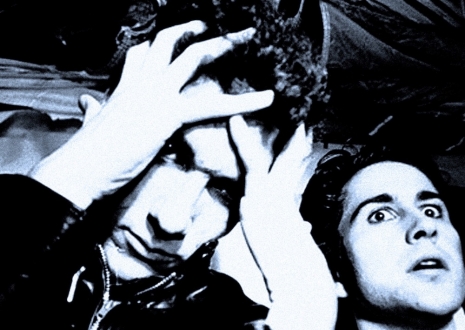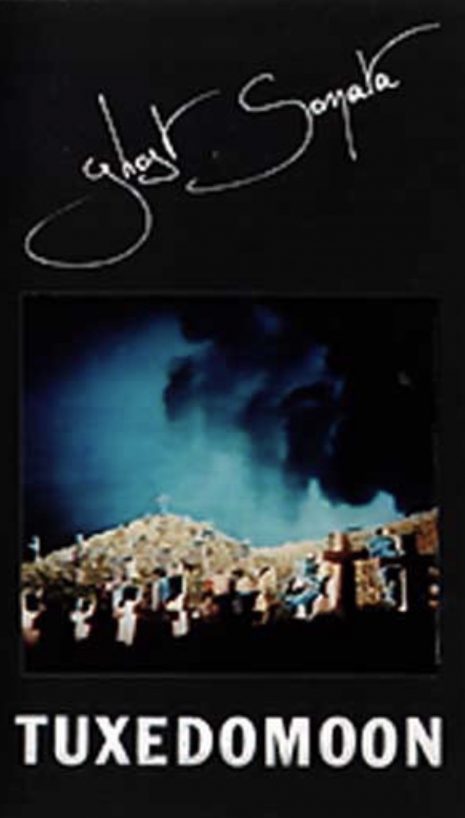
It’s been interesting watching people bid farewell to the year 2017 all week on social media. After 2016, in which we lost Bowie and Prince and we all had to stomach the gut-wrenching shock of Trump’s electoral victory, it hadn’t really occurred to me that folks were going to perceive 2017 in similar terms, but (of course) the nearly daily disgrace of Trump’s vomitous Twitter feed as well as emboldened Nazis all across the U.S. and Europe and the worst piece of legislation in a generation or more (I refer to the tax bill) and the very existence of Roy Moore as a senatorial candidate and on and on—all of it was cumulatively enough to get people expressing their loathing.
It would be understandable if two consecutive years of such arrant awfulness has you regarding the world in a “burn it all down” kind of mood—and if that’s the case, Tuxedomoon’s video piece “Ghost Sonata” might be just the thing for your current headspace!
Few American bands have been as staunchly “European” in tone as Tuxedomoon, who were originally from the San Francisco area. (Indeed, Winston Tong had been a mime and puppeteer before joining the band.) “Ghost Sonata” takes its title from a 1908 play by the Swedish playwright August Strindberg, whose works are marked by a tendency to wallow in world-weary misery. I don’t know this particular play of Strindberg’s, but the conceit behind Tuxedomoon’s project is that it consists of several parts that are yoked together in that they depict the suicides of the various characters. Bruce Geduldig explains:
It all started when we were approached for a project by two different parties: Image Video in Brussels and In Teatro in Polverigi. We imagined creating a body of music and at the same time shooting an episodic story on video. We would then transfer the video to 16mm film for large live projection, and add taped musique concrete and an orchestra. I don’t exactly recall the inception, except that Winston liked the title “Ghost Sonata.” We skimmed a copy of the original play by August Strindberg and mentally tossed it in the trash, because it was a kind of traditional piece complete with a deranged grandfather, so we only kept the fin de siècle time frame and the title. Late one night before we’d actually started Winston and I were driving and he said something to the effect of letting each member write his own suicide, and that would be the text. I liked that immediately. At some point we all decided to do “an opera without words,” an idea that seemed pretty reasonable at the time, and only much later struck me as being strange.
As Geduldig noted, the work is billed as “an opera without words,” but that isn’t exactly accurate. There are no conventional operatic vocal parts, true, but the work does liberally use tape loops of people speaking and the thing is basically suffused in language. Much of the music has a mordant 19th-century feel, complete with cello, violin, oboe, etc. although intermittently it comes across as a cut-up version of Mahler or some cravat-wearing dude like that.
“Ghost Sonata” was the tenth release on Cabaret Voltaire’s Doublevision imprint. According to the liner notes of Cabaret Voltaire’s Doublevision Presents DVD (released in 2004), Doublevision was a communication company that was initially founded by Cabaret Voltaire and Paul Smith in 1982 in order to release the band’s program of the same name. People forget, but in the 1980s most VHS cassettes were quite expensive—around $100—and one of the goals of the Doublevision project was not only to make available content that would not appear on regular TV but to bring the price down to the $25 range.

Among the artists who released work on Doublevision were Throbbing Gristle, Derek Jarman, the Residents, and Einstürzende Neubauten.
In 2007 “Ghost Sonata” appeared on the 77o7 Tm, the 30th anniversary limited-edition box set consisting of rarities that came out with the release of Tuxedomoon’s album Vapour Trails.
Previously on Dangerous Minds:
Tuxedomoon’s bizarre version of the Stones’ ‘19th Nervous Breakdown’ might trigger yours